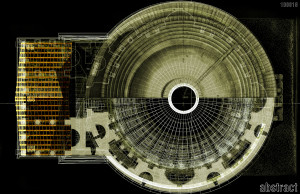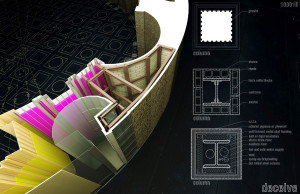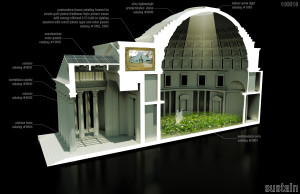About The Tale of Abstraction: a Gateway to Madness 2014
Details
Carved out of the earth and baked in the sun the first abstraction took solid shape. She wanted the brick to be part of an ideal order that could prescribe architecture. She knew the brick was durable and practical. She wanted to write in an abstract language of brick as numbers and proportions to create the visceral experience of architecture. In her mind, architecture began to appear as numerical equations. Was it possible to create the visceral experience of architecture in this language; golden by any means.
Standing in her white robe and sandals the young girl picked up the brick and held it a yard from her nose wondering “Was abstraction the answer?”
A brick as a bit, a bit of architecture, a part of a wall, an arch, or a column. If abstraction could make a brick so successful wouldn’t this thought experiment work for other materials? Was it not certain that all abstractions dissolve into numbers and then equations? If she knew the abstract values of other materials such as wood, steel, and concrete she could create architecture of any form and function regardless of the material’s intention.
She laid the brick down in the ankle high grass and walked down the hill towards the trees. She wondered what a tree could do if abstracted into bits. She would have to kill the tree first. In her white robe she swung her father’s axe.
A living tree can clean the air, provide oxygen, conserve water, harbor wild life, provide shade, prevent soil erosion, provide food, and express the time of the year. Architecture by abstraction kills the tree and transforms the dead substance into faux bricks. Thousands of bricks or hundreds of wood pieces butchered into platonic geometries to then be further assembled into greater abstractions of nostalgic brick architectures.
She laid down her father’s axe, piled the wood scraps together and started a fire. Not only had she abstracted practical geometries to build architecture, she had also abstracted energy. She wondered what she could do with this energy. What could she abstract from the ore of the earth and the sand of the beach?
She was certain the limits of a material’s structure and form were established by abstractions and numerical equations, the numerical patterns told her so. All she needed were materials to fit the prescribed functions and perform as she desired. By tearing out her mother earth’s intestines, chopping and cutting them up into manageable pieces and stitching them back on to the surface of her mother’s skin she could prescribe great architecture convincingly. After all, why else would her father have given her the axe?
The ankle high grass and trees stood frightened. The brick waited patiently.
Generations later, in her steel framed glass house the young girl stood frightened. She peered out her glass walls toward the ankle high grass and imagined walking down the hill towards the trees. She wondered what a brick could do to glass. Was she feeling trapped?
An air conditioner can clean and cool the air. A toilet can conserve water. Wet insulation and gypsum board can harbor life and fungi. Concrete reinforced by steel can provide shade and prevent soil erosion. Hydroponic systems under artificial light powered by sun energy converting silicon can provide food. What time of year was it?
Standing in her white robe and sandals the young girl picked up the brick and held it over head “Was abstraction the answer?”
She turned around facing what she had always thought of as a granite column supporting her entire steel frame roof and linking her to the clouds of memories above. Could the column be steel wrapped in concrete and terracotta blocks covered in paint? Was the granite column wood sheathed in more wood covered in spray-on plastic poly-goo? The granite column might just be extruded and 3D printed plastic. How does information, water, and electrical current travel through granite? She couldn’t be certain anymore.
She had asked her father to abstract all of reality and history into memories stored as numerical data in the clouds, accessible at any time. She could always access the clouds to remember things she didn’t know and memories she had never experienced. If she wondered how grass felt in sandals, she pressed a button. If she wondered what trees did, she pressed a button. If she wondered who she was she pressed a button. She turned away from the granite column and faced the glass wall again.
Beyond her reflection in the glass wall a clown with bright red lips pranced around replacing ankle high grass with blue cubes, yellow spheres, and green pyramids. The clown wanted to write in the abstract language of abstractions.
In her mind, paranoia began to appear as numerical equations on the glass. The equations fell to the floor raining over her reflection. Was it possible to create the visceral experience of architecture or anything anymore? How many buttons did she have to push? Who was that staring back at her?
She threw the brick through the glass wall.
The glass wall shattered and the brick landed in the ankle high grass.
The clown with bright red lips offered her an axe. The brick waited patiently.
The clown asked her “What does a brick want to be?”
“Not a thought experiment.”
Blank Space Competition Fairy Tale Competition
Location: the mind
Client: Blank Space Competition
Team: Chris Teeter, Madison Teeter
Date: 2014-05-15
Status: unbuilt




